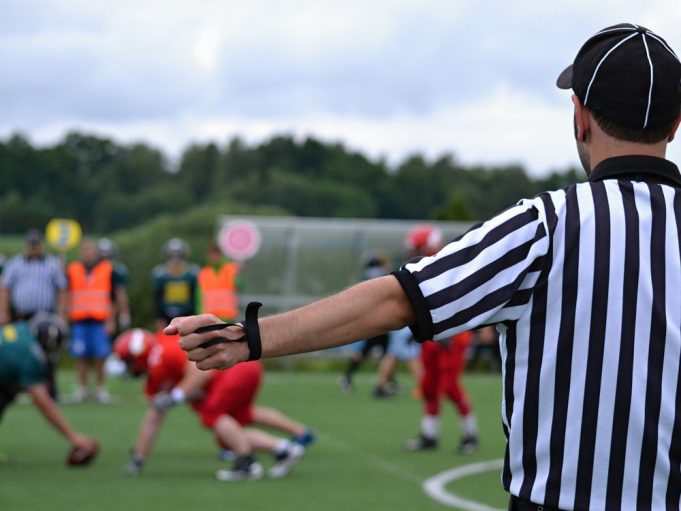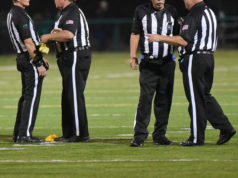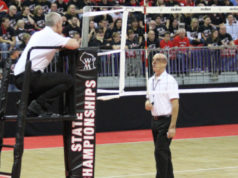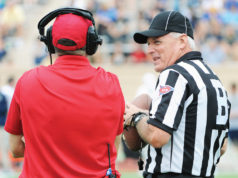The key word for officials is accommodation. You can’t deter a team from setting its own pace in a game. Teams have a right to the game they want to play and officials must officiate the game the teams are playing, including when they are using the no-huddle offense.
Accommodation also means two requirements for the referee and umpire: being agile and being mobile. In some cases those are large expectations for officials whose customary patterns may be more casual.
The no-huddle is a prominent attack right now and it is likely to become more popular in the future. Psychologically it is the “copy-cat” factor. So many teams are using it, it seems to be contagious. Psychologically, it is also an attempt to intimidate an opponent. Frankly, it has numerous advantages, some of which have propelled teams to use it almost exclusively in college ball. At that sophisticated echelon, teams frequently employ the no-huddle to prevent defenses from changing schemes or making substitutions. In regular-tempo games, defenders often bring in specialists to handle third and long or third and short situations. Often as many as four or five substitutes will filter in to prepare for those game circumstances. High schoolers, on the other hand, are likely to use the no-huddle mainly to run more plays, to increase the odds in their favor. So preventing defenses from adjusting may not be their primary goal.
You read about large linemen being recruited intensely by colleges. To understate it, at the high school level, a 300-pound, 6’4” behemoth will establish a presence. He can knock people down. It is common sense that teams will depend upon such a player to open holes in the line. From another angle, a team may have a spectacular passer or a “glue-fingered” receiver. The no-huddle can readily capitalize on their abilities.
So it’s no mystery why teams will want to adopt the speed-up process. The hard part for them will be to develop signals that will confuse defenses. But that is no matter for officials to decipher.
Here are suggested ways, though, for officials to operate. First, the umpire must get to the pile with a sense of urgency when a run ends between the hashes. He should reach in and extract the ball from the runner whenever possible, all while talking players off the pile: “Watch your legs. I’ll take the ball. Don’t push off opponents to get up.”
When a run ends behind the line of scrimmage, it’s the referee’s obligation to rush to the downed runner, secure the ball and get it to the umpire (or place it himself if a wing official has a progress spot). The referee should be particularly alert for identifying a progress spot on quarterback sacks while he retrieves the ball.
The umpire must then “assume the position” when the ball is placed at the succeeding spot, straddling the ball and waiting for the ready signal or for the referee to determine the substitution process is complete. That position on the ball prevents the no-huddle snapper from putting the ball in play prematurely.
That entire process must be done with some dispatch. Counting players and checking for eligibles, plus noting the legality of the formation (wings), must be done quickly and accurately too.
On runs that end outside the hashes, the umpire should exhibit flexibility, sprinting at least to the middle of the numbers, again extracting the ball and scooting back to the hash for ball placement. When a run goes closer to the sidelines the wing official should get to the downed runner and take the ball. Usually he’ll be able to get the ball and maintain a progress spot as well.
That is where customary practices may differ. In some areas it is fashionable for the referee to withhold his presence in relation to the ball; in fact conducting the entire game without touching the ball, like a master of ceremonies. If he won’t hasten toward the sideline to assist in ball retrieval, the umpire will have to extend his range and go out wide far enough so that the relay will not be overly long (and hence inaccurate at times). In my view the referee should get out there to be the middle man in the relay. I always was determined to be an active referee.
The real problem for helping a team in its no-huddle is if a play gains a considerable distance downfield along the sidelines. In those instances an alert back judge must aid in collecting the ball, with the covering wing official rooted to the progress spot.
A couple of possible difficulties may ensue on long gainers. The chain crew may be desultory, reluctant or unable to move quickly. In an extreme case a linesman can drop a beanbag at the place for the succeeding spot — where the down box will be if team A is lined up ready to run the next play. Other trying issues are runs going out of bounds and incomplete passes that sail past the umpire. In both cases officials should contrive to get a replacement ball from ball persons at the sidelines. If they are unable to do that, the no-huddle procedure will suffer an unfortunate delay. At times there is no remedy for such a slowdown. Eager-to-snap teams will often merge into a huddle after incomplete passes anyway, making their own decision to pause.
A word about the hurry-up offense near the end of either half. Officials can operate under their same protocols as the no-huddle, keeping in mind that team A’s purpose will be to use the clock to its advantage. A caution: In the final stages of a half, wing officials must be conscious of coaches’ desire to request a timeout. No coach should be cheated out of time to which he is legitimately entitled.
Another purpose of the no-huddle, to be sure, is to wear down opponents, and in the course of pulsing along that may also wear down the officials. But if crew members move rapidly to cover game action, synchronize their ballhandling and exercise due diligence to the teams’ preferred tempo, they are likely to come away with a firm sense of being true facilitators. They might not be formally thanked but they can pat each other on the back in the locker room.
What's Your Call? Leave a Comment:
Note: This article is archival in nature. Rules, interpretations, mechanics, philosophies and other information may or may not be correct for the current year.
This article is the copyright of ©Referee Enterprises, Inc., and may not be republished in whole or in part online, in print or in any capacity without expressed written permission from Referee. The article is made available for educational use by individuals.


















